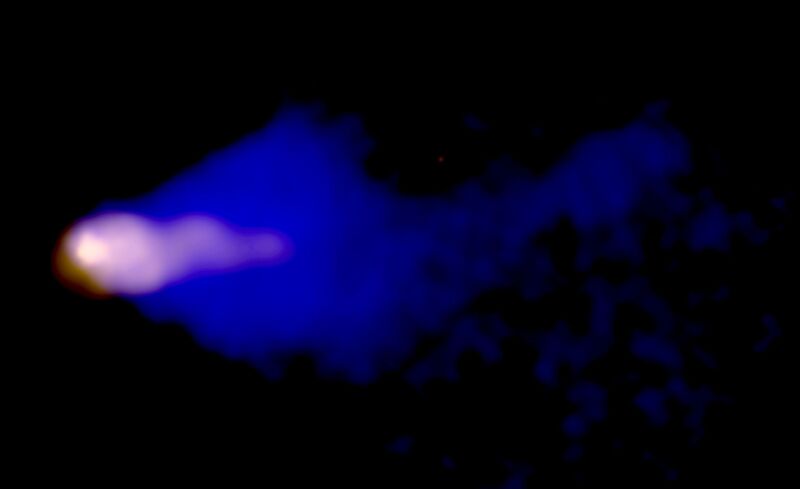VLA Radio & Chandra X-Ray Composite of the Mouse
Description
The Mouse (a.k.a. G359.23-0.82) gets its name from its appearance in radio images that show a compact snout, a bulbous body, and a remarkable long, narrow, tail that extends for about 55 light years. This image, a composite X-ray (gold) and radio (blue), shows a close-up of the head of the Mouse where a shock wave has formed as a young pulsar plows through interstellar space. Pulsars are rapidly spinning, highly magnetized, neutron stars left behind after the explosion of a massive star. Winds of high-energy particles from pulsars create large, magnetized clouds of high-energy particles called pulsar wind nebulas. In the case of the Mouse, the pulsar-wind nebula is swept back by the rapidly moving pulsar's interaction with the interstellar gas. Near the front of the nebula an intense X-ray source marks the location of the pulsar, estimated to be moving through space at about 1.3 million miles per hour.
The X-ray cloud consists of high-energy particles swept back by the pulsar's interaction with the interstellar gas. Near the front of the cloud an intense X-ray source marks the location of the pulsar, estimated to be moving through space at about 1.3 million miles per hour. A cone-shaped cloud of less energetic, radio-wave-emitting particles envelopes the X-ray cloud. Pulsars are rapidly spinning, highly magnetized, neutron stars. Their formation is associated with the collapse and explosion of a massive star. Most pulsars get accelerated to a high speed by some mechanism - presumably related to the explosion - that is still unknown. Winds of high-energy particles from pulsars create large, magnetized clouds of high-energy particles called pulsar wind nebulas. A few dozen pulsar wind nebulas are known, including the spectacular Crab Nebula, but none have the Mouse's combination of relatively young age and incredibly rapid motion through interstellar space. In effect, it presents astronomers with a supersonic cosmic wind tunnel that they can use to estimate the speed of the pulsar and to study the effects of the pulsar's motion on its pulsar wind nebula.
Creator
Legacy Astronomical Images
Rights
NRAO/AUI/NSF does not hold full copyright for this image. Contact the archivist for details.
Type
Legacy Astronomical Image
Object Name
The Mouse
Photo Credit
Chandra: NASA/CXC/SAO/B.Gaensler et al.
Telescope
Very Large Array (VLA)
Type of Observation
continuum
Band
L
Wavelength
20 cm
Frequency
1.4 GHz
Center of Image
RA 17:47:15.000, Dec: -29:58:1.000 (J2000)
Field of View
0.041667 x 0.025000 degrees
Notes
Contact the archivist for a high resolution tif of this image.
Series
Galactic Sources Series
Unit
Pulsars/Neutron Stars Unit
Citation
Legacy Astronomical Images, “VLA Radio & Chandra X-Ray Composite of the Mouse,” NRAO/AUI Archives, accessed June 14, 2025, https://www.nrao.edu/archives/items/show/33473.

